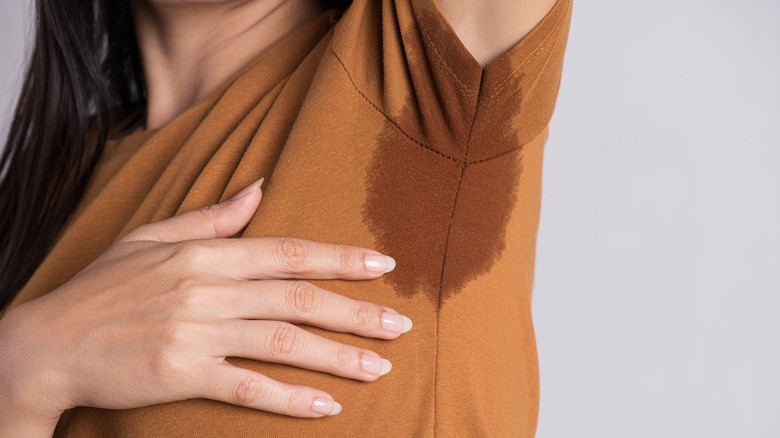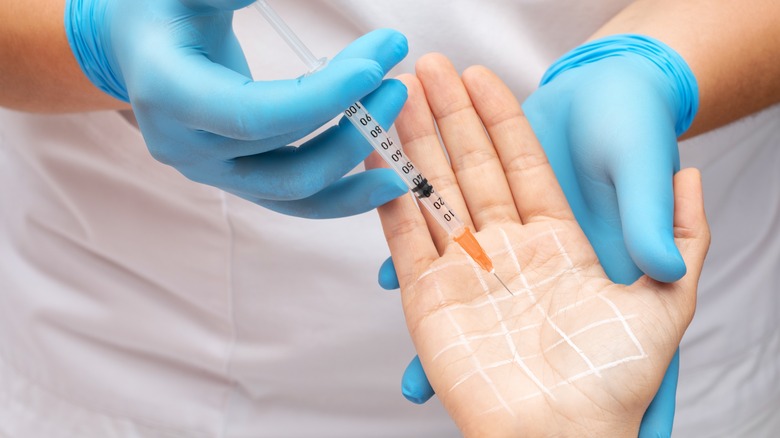Here's How You Can Treat Hyperhidrosis
Hyperhidrosis, or excessive sweating, is no joke for sufferers of the condition. Overactive sweat glands can lead to embarrassment and anxiety in social situations. If you're dealing with hyperhidrosis, you may even avoid things others take for granted, like shaking hands, raising your arms, or wearing certain clothing.
While the cause of hyperhidrosis isn't entirely clear, it affects about 5% of the global population, according to The International Hyperhidrosis Society. Though excessive sweat can be a side effect of other illnesses, hyperhidrosis is often found in people without any underlying medical conditions. Furthermore, excessive sweating in hyperhidrosis patients can occur without the presence of typical environmental triggers like hot weather or strenuous exercise. For those who struggle with the disorder, it can be challenging to conceal and may even result in isolation and mood changes. Furthermore, a study published in Advances in Dermatology and Venerology found that patients with hyperhidrosis were more likely to suffer from anxiety and depression than any other dermatology patients.
Still not sure whether your sweating is considered normal or indicative of hyperhidrosis? "The simplest definition of hyperhidrosis is excessive sweating that is beyond what would be expected from whatever the trigger of the sweating is," Dr. Marlyanne Pol-Rodriguez tells Self. So, how can you make hyperhidrosis go away for good?
Topical interventions that treat hyperhidrosis
Some of the oldest and simplest treatments available for people with hyperhidrosis are topical antiperspirants. While the antiperspirants that line the shelves at stores generally contain about 7% aluminum content, those targeted at blocking excessive sweating may contain upwards of 20% aluminum content. Many patients with hyperhidrosis have reported success with using high-strength aluminum antiperspirants marketed under names such as Certain-Dri. "[Certain-Dri] turned my armpits into a desert, [but with] prolonged use became a bit irritating. Still, it worked great," wrote Redditor Fruitbrute77.
Keep in mind that prescription-strength antiperspirants can cause skin irritation, and you may notice compensatory sweating from other areas of your body. Common side effects can also include stinging or prickling sensations, rash, and itchiness (via research published in Current Problems in Dermatology). If you notice any of these symptoms, your best bet is to take a day or two off from utilizing the topical medication and apply a smaller concentration when reintroducing the product. However, if you still experience issues, try speaking to your dermatologist or doctor about an intermediate dose or alternative topical treatments. Advancements in treating hyperhidrosis have been significant in recent years, and there may be better options for your particular situation.
Other solutions for those with excessive sweating
An uplifting fact for those with hyperhidrosis is that many treatment options are now available. In addition to topical agents, various advanced therapies exist, including surgical intervention. One solution, Botox, is more commonly associated with reducing wrinkles rather than excessive sweat, but its effects can't be overlooked as a hyperhidrosis treatment. Introduced for use in managing hyperhidrosis in 1994, Botox has proven to be an effective strategy in treating overactive sweat glands (via research published in The Journal of the Royal Society of Medicine).
Patients who have used Botox for hyperhidrosis report that the neuromodulator effectively reduces facial, underarm, and palm sweating. "It worked very well for me: [I was] dry about 95% of the time. It sadly only lasted 2-4 months, though," Redditor Vacationperson wrote. Their results are typical of what can be expected from Botox treatments, as the effects last for about three months, according to the Mayo Clinic.
Iontophoresis is another popular hyperhidrosis treatment that works to deactivate sweat glands by channeling an electric current through a water bath. Iontophoresis is considered safe, and physicians have used it to treat patients since 1952, according to research published in The Annals of Dermatology. Dermatologists are big fans of iontophoresis, and it's gentle enough that patients can perform it themselves using at-home devices like DermaDry. Try speaking to your dermatologist to find out if iontophoresis or other advanced hyperhidrosis treatments could work well for you.


